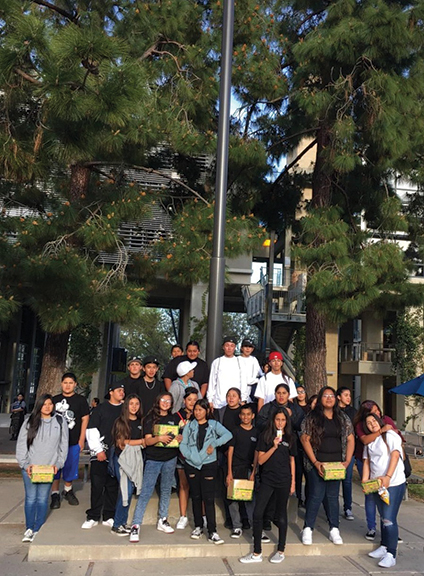The Valley Chronicle - Native youth dream the impossibleng
Native youth dream the impossible
·
4 min read
Soboba Tribal TANF takes 35 to conference
[caption id="attachment_2359" align="alignright" width="424"] Courtesy of Soboba Tribal TANF
Courtesy of Soboba Tribal TANFSoboba Tribal TANF took about 35 Native American youth to the 11th annual Dream the Impossible conference at University of California, San Diego on March 18.[/caption] ■ By Mike Hiles / Contributed Soboba Tribal TANF supported about 35 Native American youth attending the 11th annual Dream the Impossible (DTI) conference at the University of California, San Diego on March 18. Youth ages 12 to 19 attended workshops on college readiness, NCAA requirements, culture, health and wellness and prevention. They were treated to a tour of UCSD’s campus and attended a college fair to learn about other schools. DTI’s purpose is to encourage youth to dream big -- to dream of being anything they want to be and dream of greatness. As long as they have a dream, they will always have something to reach for in life. It also exposes students to various college campuses, eliminating the fear or intimidation of walking around a college campus. “Another goal is to empower the youth to take charge by allowing them the opportunity to tell us as advisors and program managers what interests them,” said Shonta Chaloux, one of the conference founders. “Students design the conference logo, select conference topics, location, color of shirts, afternoon activities and decide on what meals will be eaten during the conference.” Surveys are conducted before and after each conference to assist planners. Information is collected on speakers, activities and workshops and overall attendance experience. “We encourage all youth to attend,” said Annalisa Tucker, who works at Soboba Tribal TANF Prevention Resource Center. “This is a great opportunity for them to network with other native youth, hear powerful words and be exposed to higher education.” Tucker has attended the conference since she started working for Soboba Tribal TANF about 10 years ago. She was joined by Harold Arres, San Jacinto City Councilwoman Crystal Ruiz, Aurelia Mendoza, Elena Torres, Steve Lopez and Ricardo Macias to guide youth throughout the day to workshops and activities. Tucker said the conference provides youth the opportunity to see Native Americans in positive roles they can relate to and learn how to achieve their goals. Asona Arres, 14, said she attended the conference last year and had so much fun she wanted to go again this time. One thing she said she learned that she didn’t know before is that “you can work out to traditional music.” Her dad and sisters also went and she said the delicious food was a definite highlight of the day. She attended workshops on NCAA and Pow Wow Sweat. “It was awesome,” said the eighth-grader from Soboba. Chaloux, who is currently the director of TANF at Pechanga Indian Reservation, is a member of the planning committee that consists of about 25 individuals representing more than 20 tribes from Riverside, San Bernardino and San Diego counties. Committee members’ roles throughout the conference include chaperoning youth, picking up speakers, manning the registration booth, setting up classroom layouts, organizing volunteers, welcoming participants and various other duties. As a co-founder, Chaloux recalls how it all started in 2007. “Riverside-San Bernardino County Indian Health employees from the Native Challenge program asked if they could host a prevention concert at Soboba,” said Chaloux, who worked for Soboba at the time. “Naomi Borel (now Magee) held a meeting with several tribes and their youth councils to get input from the youth. What came out of those meetings was DTI, a conference specifically put together by Southern California Youth Councils, tribes and tribal organizations.” The conference name of Dream the Impossible was created by the youth in a local planning session and the initial conference was held on the Soboba Reservation using Noli Indian School and the Soboba Sports Complex. “The conference has grown simply by the increase in the number of tribes and students who continue to participate,” Chaloux said. “I would say the biggest improvement is with the organization and collaboration between tribes.” DTI is designed to accommodate about 400 attendees and there is no registration cost for participants due to the many contributions and collaborations between Tribal TANF agencies and support from local tribes. “We hope all youth will take back to their homes and schools the message that no matter what challenges or barriers life puts in your way, find the courage and strength to achieve your dreams,” Chaloux said. “D=Dedication, R=Responsibility, E=Education, A=Attitude, M=Motivation.” About TANF: In 2005, The Soboba Band of Luiseño Indians were designated to implement and administer the Tribal TANF program for Indian Families living on the Soboba Indian Reservation and within the city of Riverside. Tribal TANF is a federal and state funded program that provides time-limited assistance to needy families with children in an effort for those children to be cared for in their homes or in the homes of relatives. The Tribal TANF program was created by Native Americans to provide cash aid assistance and supportive services to meet the specific needs of Native American families. Tribal TANF is designed with the flexibility to address and focus on a variety of cultural and traditional needs. Source: Sobobatanf.org
S
